市场资讯及洞察
.jpg)
摘要
IEA 最新月报显示,全球石油需求增速放缓但仍具韧性。尽管库存持续回升,但 OECD 库存整体仍低于五年均值,市场对供应中断高度敏感。OPEC、IEA、EIA 均上调非 OPEC 供应,未来可能出现“松中带紧”的供需结构。原油价格在供应宽松预期与地缘扰动之间反复震荡,波动率下降但敏感度上升。油市表现也可能通过风险偏好外溢至能源板块、商品货币及相关市场。
一、全球原油供需前景:IEA 月报核心要点
国际能源署(IEA)最新原油月报显示,全球石油需求虽较去年降温,但整体依旧保持韧性 [1]。先进经济体消费表现好于预期,有效抵消部分新兴市场的疲弱需求。IEA 预计 2025–2026 年全球石油需求将保持温和增长。然而在供应方面,如果 OPEC+ 维持当前产量政策且需求不出现明显下滑,全球石油市场未来数个季度可能重新进入“边际紧平衡”状态。IEA 同时指出,高油价、全球经济放缓、电动车渗透等因素正在逐步压制需求增速,使油市呈现出“短期紧平衡、长期温和宽松”的结构。
二、多机构观点对比:OPEC、EIA 与 OECD 数据
三大机构对于未来市场平衡的看法存在显著差异,这主要源于对非 OPEC+ 供应增长和需求韧性的不同假设。总体来看,市场普遍认同未来供应将更加充裕,但对于过剩的规模和时间点存在分歧。

图 3:三大机构对 2025-2026 年需求与供应增长的预测对比,显示供应增长普遍超过需求增长,预示市场将进入供应过剩周期。
OPEC 的观点相对乐观。OPEC 预计 2025 年全球石油需求将增长约 130 万桶/日,2026 年略高至 140 万桶/日 [2]。与此同时,OPEC 在最新报告中连续上调非 OPEC 供给预期,并首次将 2026 年市场从“短缺”调整为“小幅过剩”,反映其判断未来供应增长可能快于需求。
EIA 的判断更偏向供应充裕。EIA 上调了美国页岩油产量预测,指出 2025 年美国原油产量将创历史新高。同时,全球供应预期被上调至日均 1.06 亿桶,高于全球消费的 1.041 亿桶,意味着未来库存可能持续累积 [3]。EIA 预期 2025–2026 年库存增加将对油价形成中期压力。
OECD 库存虽然持续回升,但仍低于五年均值。IEA 数据显示,今年全球观测库存前八个月净增约 2 亿桶,但 OECD 商业库存仍比五年均值低约 6700 万桶。整体来看,库存虽然恢复,但仍处历史偏低区间,使油市对供应中断的敏感度依旧很高。
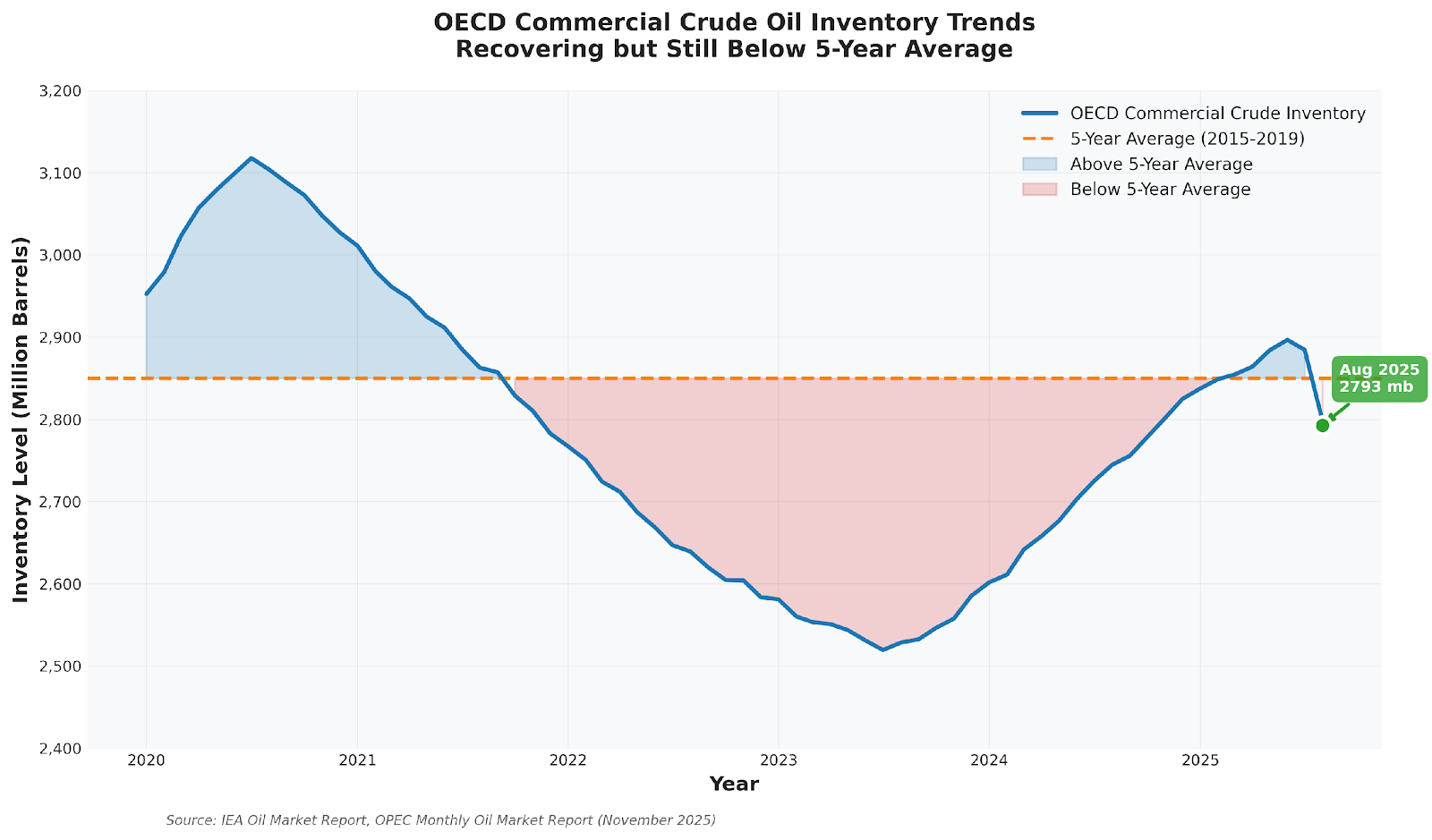
图 1:OECD 商业原油库存近 5 年对比最新水平,显示库存虽有回升但仍低于五年均值。
三、原油价格走势:WTI 与 Brent 如何消化预期
2023 年下半年,布伦特因供应紧张和地缘冲突预期一度突破每桶 90 美元。然而进入 2024–2025 年,随着供应回升和库存恢复,油价整体震荡下移。近期价格承压主要来自供应过剩预期强化以及美国库存意外上升。
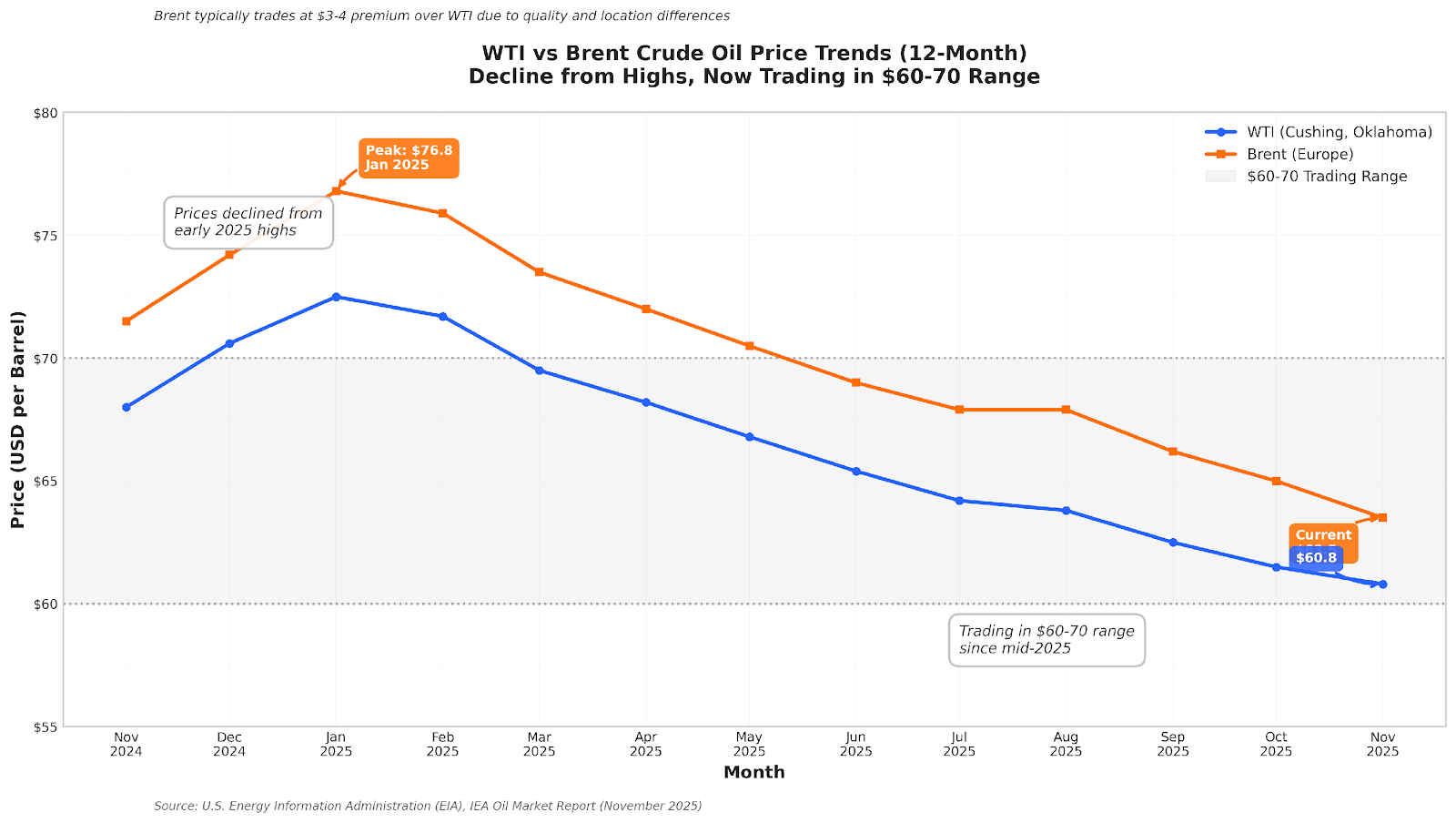
图 2:WTI 与 Brent 价格从 2025 年初的高位回落,近期在 60–70 美元区间震荡。
尽管地缘事件偶尔推升价格,但反弹难以持续,因为供应宽松的结构性预期迅速重新主导市场。WTI 与 Brent 的期限结构一度出现小幅 Contango,显示短期供应充裕压制近端价格,而远月因长期需求预期而保持相对坚挺。整体来看,油市呈现低波动、弱趋势但对消息高度敏感的特征。
四、驱动油市的关键变量:地缘政治与供应端不确定性
运输通道风险仍是油市最大的潜在冲击点之一。全球三分之一海运原油经过霍尔木兹海峡,一旦受阻便可能引发油价剧烈波动。衍生品定价显示断供概率虽低,但属于典型的“低概率、高冲击”事件。
OPEC+ 的政策滞后性也带来结构性波动。减产会压低库存、推高价格,但高油价又刺激非 OPEC 增产,使市场重新宽松。美国页岩油增速放缓进一步加剧供应端的不确定性,削弱其作为“摇摆产能”的角色。此外,俄罗斯、伊朗等国因制裁和冲突导致出口波动,更加剧油市敏感性。
五、油市变化的外溢影响
能源板块通常与油价同方向变动,但反应速度较油价更平缓。油价对风险偏好的溢出效应也容易影响澳元等商品货币。大宗商品价格上行往往提升商品出口国的贸易条件与风险情绪,而价格下跌则可能压制相关货币表现。
六、原油市场风险提示
- 数据发布风险: EIA 每周库存、IEA 与 OPEC 月报可能导致短线波动。
- 地缘政治风险: 产油区冲突、海运通道中断、制裁变化均可能影响供需平衡。
- 宏观风险: 利率政策、美元走势及全球经济增速变化都可能改变需求前景。
结语
IEA 最新展望显示,全球油市进入“边际紧平衡”阶段:库存修复但仍偏低,供应端不确定性大于需求端。在这种结构性环境下,油市会对政策、地缘事件与供给变化表现出高度敏感。理解供需框架、关注库存趋势与识别关键风险,将是未来判断油市走向的关键。
参考资料
[1] IEA (International Energy Agency). (2025, October). Oil Market Report - October 2025. https://www.iea.org/reports/oil-market-report-october-2025
[2] OPEC (Organization of the Petroleum Exporting Countries). (2025, November). Monthly Oil Market Report. https://publications.opec.org/momr
[3] EIA (U.S. Energy Information Administration). (2025, November). Short-Term Energy Outlook. https://www.eia.gov/outlooks/steo/


热门话题
屋漏偏逢连夜雨,船迟又遇打头风——冯梦龙《醒世恒言》用这句名言形容日本经济那可是再贴切不过了在日本造就了90年代最大的资产泡沫之后,央行意识到,是时候该我出手了。于是和其他大多数国家应对泡沫时候的做法,那就是降息。从1991年开始,花了两年多的时间把利息从6%降到了1.75%。但是整体效果并不是很好,失业率从之前的2%来到了3%,经济实际上还是处于一个萎缩的阶段。反观2001年互联网泡沫时期,美国一年时间不到就从6.5%降息到了2%,并且顺利的度过了这次危机。其实本次降息效果不是很好的原因有一个就是,适逢当时美国也是处于降息周期,作为全球第一大经济体,当时美元开始贬值,反向导致了日元升值,日本的出口业受到打压,因此,才导致了本次降息并没有预想的效果那么好。于是,在1995年,1.75%的利息位置了几年之后,终于在把利息降至了0.5%,央行准备给经济注入一剂强心针。
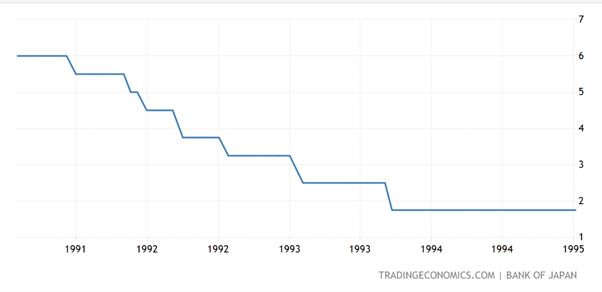
(日本利率-Source:tradingeconomics)那么央行的货币政策出手了,政府的财政政策也不闲着。开始进行财政支出,开始做各种基建项目,刺激需求,拉动内需,经济开始有好转。但是,其实本次的“强心针”计划用一句话形容就是--“金絮其外,败絮其中”,因为本身最大的问题并没有解决,那就是信用膨胀的问题,其中公司,银行之间的坏账愈演愈烈。于是在1997年开始了很多银行,保险公司的破产潮,苟活的公司把好公司继续拉下水,大家一起摆烂。这就出现的信贷收缩的问题,发现市面上没人贷款了。到了1998年,民间贷款的数量极具下降,大家的钱开始变少了,流入市场的钱也变少了。于是,在2000年前夕,日本陷入了一个巨大的漩涡当中,人们购买欲望降低-->需求下降-->不得不降价出售-->物价开始下降-->营业额利润下降-->大家的收入下降-->需求继续下降。这个漩涡在当时看似好像没那么严重,也就是市场的活跃度开始下降,但是从后世眼光来看,这个漩涡,其实日本一直都没有走出来,不过这也是后话了。在当时,实体经济出现危机,公司之间相互摆烂,就造成效益越来越糟糕,于是滋生出了破产潮和裁员潮。这样一来,大家的钱再次变少,失业率飙升,从1997年的3.4%到了1999年的4.75%,在2002年和2003年,更是达到了历史高位的5.5%。更可怕的是,通过这一番折腾,日本从1998年开始陷入了通货紧缩的泥潭,通货膨胀率降到了0以下。
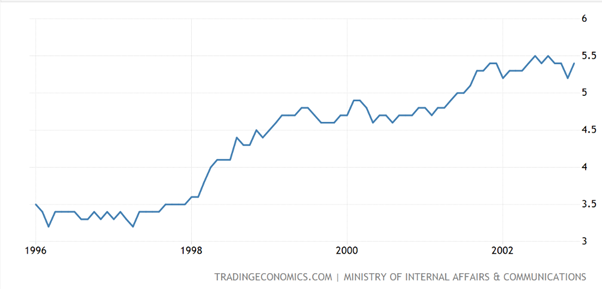
(日本失业率-Source:tradingeconomics)

(日本通货膨胀率-Source:tradingeconomics)政府一看,这不行啊,得刺激经济呀,但是因为税收等的种种原因,子弹不够重组。于是开始了不断发债,来进行做项目刺激内需,刺激经济。从1997年的100%的债务GDP比,迅速攀升至了2005年的176.6%。值得一说的是,在1991年的时候,日本的债务GDP比也才66.5%,短短十几年,翻了快三倍了。央行此时一看,友方开始搞大的了,那我也不能闲着,在1999年2月底,日本央行把利率调为了0,也是世界首创的0利率国家,这一操作,也是颠覆了世界上很多经济学家的认知。
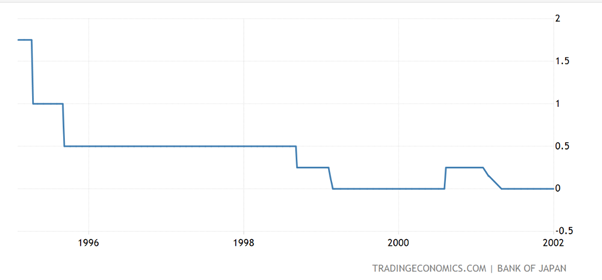
(日本利率-Source:tradingeconomics)这次央行和政府联合出手也是给日本经济注入了第二针强心针。也是在1998年底,top secret 在英国A1高速上跑出了320km/h的急速,让JDM改装车在全世界范围内发扬光大。但是,光借钱好像总是缺了点什么,似乎有点不够,于是在2001年的时候,创造出了我们现在耳熟能详的量化宽松(QE)。量化宽松一词是由日本央行于2001年提出,是指央行刻意通过向银行体系注入超额资金,包括大量印钞或者买入政府、企业债券等让基准利率维持在零的途径,为经济体系创造新的流动性,以鼓励开支和借贷。 一般来说,只有在利率等常规工具不再有效的情况下,货币当局才会采取这种极端的做法。由于量化宽松有可能增加货币贬值的风险,政府通常在经历通货紧缩时推出量化宽松的措施。而且,在某种意义上,央行拿着这些凭空而来的钱在市场尽心购买操作,很有可能会造成乱套的情况,而且还极有可能导致通货膨胀的发生。然而,后面这个导致通胀的点,正中日本央行的下怀,其他不好的地方也管不了啦,直接开始量化宽松,搞定通胀率,盘活经济,其他的,以后都可以慢慢的去解决。在2001年开始大量印钱,随着而来的就是日本央行资产负债表的攀升,从2001年到2006年,几乎是翻了一倍。随之而来的贷款有所回升,但是并没有回升地很猛烈。
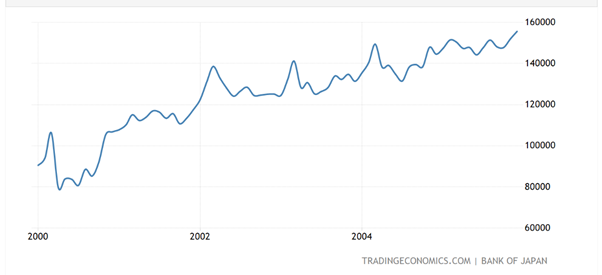
(日本央行资产负债-Source:tradingeconomics)恰逢2000年时期是全球范围内的经济大发展,各个国家的外需扩大,日本再加上其强力的刺激政策,终于是使得失业率从5.5%下降到了4%,出口增长了近1.5倍,经济开始逐渐恢复。

(日本出口-Source:tradingeconomics)一切都逐渐开始好转的时候,于是在2006年后期,日本宣布撤出量化宽松,并不需要这样激进的进行刺激了,慢慢的经济可以自己开始良性循环了。2008年早些时候,永田和彦和他的金色Supra更是在意大利跑出了公路急速380km/h,Top secret 和JDM 荣光焕发。

在2008年,日本再次经历了梦碎。2008年,美国次贷危机所带领了世界范围内的金融危机再次让日本出现危机。日元在这个时期快速升值,出口直接腰斩,更是使得失业率回到了高位5.5%。日本又一次的进入了经济衰退。
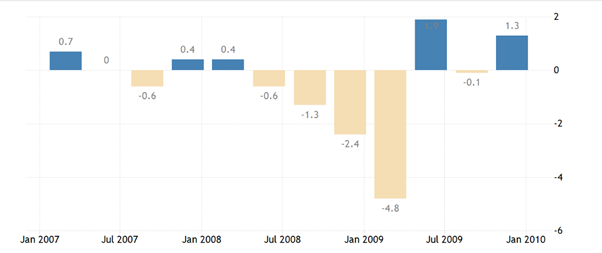
(日本GDP增长率-Source:tradingeconomics)然而就像我开头的—“屋漏偏逢连夜雨,船迟又遇打头风”, 在2011年,日本福岛核电站出现了泄露。距最新统计,其中处理,维护,等等费用将可能达到3.1万人民币(约4600亿美元)。此次事件政府突如其来巨大花费,出口受到限制,而且中韩出口的崛起也对于其出口业进行再次打压。短短三年时间,连续两次巨大变革导致日本的通胀跌入谷底,失业率又又又飙升,再再再次陷入衰退。于是日本又回到之前的老路上,利率从0.5%回到了0利率,继续QE量化宽松。但是效果嘛,不用我多说,也就那样。时间到了2012年,日本两大重磅高手开始登场,分别是日本首相安倍晋三和日本央行行长黑田东彦,在两人“卧龙凤雏”的努力下,创造了近代历史上最大的刺激方案,也让“安倍经济学”响彻世界。最终“”安倍经济学”有没有发光发热呢?后来又有没有发生什么事件呢?下期回合大家聊聊日本的第三剂,也是最猛的强心针。欢迎大家观看以及分析讨论。免责声明:GO Markets分析师或外部发言人提供的信息基于其独立分析或个人经验。所表达的观点或交易风格仅代表其个人;并不代表GO Markets的观点或立场。联系方式:墨尔本 03 8658 0603悉尼 02 9188 0418中国地区(中文) 400 120 8537中国地区(英文) +248 4 671 903作者:Neo Yuan | GO Markets 助理分析师


What is a dividend? A dividend is a payment made by a company to its shareholders to give back some of its profits or return. Dividends are most often paid to shareholders, annually, semi-annual, or quarterly.
Non annual dividends that are paid periodically are known as interim dividends. Companies can also pay dividends at their discretion, and these are known as special dividends. Companies that issue dividends are usually very mature and stable businesses with steady cash flow.
Index funds, or ETF’s will often also pay dividends from as they receive dividends from their underlying holdings. In Australia, well-known companies that issues consistent dividends include ‘Big 4’ banks, BHP, Rio Tinto Wesfarmers, and Qantas just to name a few. In the USA, the big banks such as JP Morgan and other mature company’s such as Walmart and Coke Cola.
Important Terms Dividend Yield - The dividend yield is the total value of all dividends paid in the year divided by the share price. Alternatively, it can be thought of as the dividend return on the market value of the share. Ex-Dividend Date – This is the date in which a holder of stock must possess the stock to receive the dividend payment.
Dividend Payment date – This is the date in which the payment is made. Do Dividends even matter? There are theories that suggest dividends don’t really provide any benefit for holders as they are just eating into the overall Compound Annual Growth Rate of the price.
This is because once a dividend is paid the share price should adjust to account for the payment that has been made to the holder. For example, company A has a share price of $100 and issues a $1 dividend. Therefore, after the payment date, the price should in theory drop down to $99.
Consequently, those who oppose dividends as opposed to the being paid a dividend it a holder of a top performing share could just sell a certain number of their units to in some respects pay themselves a ‘dividend’. On the other hand, companies that pay dividends generally allow the holder to participate in what is known as a ‘reinvestment plan’. This is a scheme in which the company allows holders to reinvest their dividends back into the company’s shares and use the payment to purchase more of those shares allowing for compounding.
These schemes often operate without needing to pay commission and sometimes the shares are discounted. The reinvestment plan also removes certain tax liabilities. For instance, look below at an example of theoretical share that trades.
Price = $10.00 Number of shares at inception = 1000 Total Investment = $10,000.00 Annual Dividend growth =1% Annual share price growth = 1% Time period = 10 years Below is the same share but with a change in the timeframe of 10 to 20 years. This highlights how important having as much time in the market as possible can make a huge difference to the overall returns of a reinvestment strategy/portfolio. The return for 10 years with reinvestment is around 1.32 times the amount for without reinvestment.
Having the same investment for an extra 10 years will yield a return a result 2.35 times better than if the dividends are aid in cash. Can you live off dividends? Dividends payments have created an ideal or goal in which traders and investors strive for is to ‘live off’ their dividends.
Creating a portfolio that is heavily weighted towards dividend stocks can be a way in which to have a periodic income to supplement a pension or salary. This process involves developing a large enough portfolio that can provide these periodic dividends to a level that will cover the cost-of-living requirements. Choosing high quality, high yielding investments can provide this outcome for those who are savvy.
Below is a list of ETF’s and ASX Listed Stocks with the highest recent Dividend Yields? List of ETF Code Company Price Yield Gross DRP 1yr Return IVV Ishares S&P 500 ETF $37.63 16.67% 16.67% Yes -10.40% IHVV Ishares S&P 500 Aud Hedged ETF $37.06 14.93% 14.93% No -16.90% HACK Betashares Global Cybersecurity ETF $7.57 8.99% 8.99% No -23.30% SLF SPDR S&P/ASX 200 Listed Property Fund $11.28 7.45% 7.52% No -16.01% VAS Vanguard Australian Shares INDEX ETF $91.89 6.92% 8.86% Yes -2.18% ILC Ishares S&P/ASX 20 ETF $28.95 6.67% 9.35% Yes +2.77% STW SPDR S&P/ASX 200 Fund $67.10 6.43% 8.42% Yes -1.19% A200 Betashares Australia 200 ETF $123.01 6.35% 8.35% Yes -0.98% IOZ Ishares Core S&P/ASX 200 ETF $29.87 5.96% 8.06% Yes -0.53% VHY Vanguard Australian Shares High Yield ETF $69.87 5.93% 8.31% Yes +5.46% SFY SPDR S&P/ASX 50 Fund $65.77 5.78% 8.01% Yes +1.78% VSO Vanguard MSCI Australian Small Companies INDEX ETF $64.70 5.54% 6.32% Yes -10.81% MVA Vaneck Australian Property ETF $21.20 5.14% 5.25% Yes -13.43% List of ASX Stocks Code Company Price Yield Gross DRP 1yr Return TER Terracom Ltd $0.99 20.20% 24.53% No +360.46% CRN Coronado Global Resources Inc $2.125 19.72% 19.72% No +40.26% MFG Magellan Financial Group Ltd $9.35 19.14% 25.46% No -53.25% YAL Yancoal Australia Ltd $6.53 18.85% 18.85% No +123.63% ACL Australian Clinical Labs Ltd $3.065 17.29% 24.70% Yes -43.24% NHC New Hope Corporation Ltd $6.67 12.89% 18.42% No +177.92% SIQ Smartgroup Corporation Ltd $5.41 12.20% 17.43% No -25.48% TAH Tabcorp Holdings Ltd $1.115 11.66% 16.66% Yes +13.99% BFL BSP Financial Group Ltd $4.80 11.36% 11.36% No +12.41% GRR Grange Resources Ltd $1.07 11.21% 16.02% No +30.49% LFS Latitude Group Holdings Ltd $1.42 11.06% 15.79% Yes -31.73% The final word Ultimately dividend portfolios can be a great step in achieving financial security and freedom and is also a great way to diversify a portfolio or trading strategy.


热门话题
*2023年将是黄金和白银的积极一年*美联储放慢加息步伐、美元走弱、全球经济放缓以及地缘政治的不确定性都是贵金属的利好因素*黄金今年可能会升至历史高点就黄金和白银市场而言,今年的开局就像在公园里散步一样轻松。过去两个月,这两种贵金属分别上涨了7.5%和12.1%。从根本上讲,价格上涨可归因于通胀降温,这是美联储放慢加息步伐的理由,从而削弱美元。近年来,美元走强和债券收益率上升一直是限制黄金和白银上涨潜力的主要因素,使它们处于盘整阶段。而从去年11月开始,这一旧趋势发生了变化,特别是今年变化更为明显。如果按照现有新趋势在未来几个月继续下去,黄金和白银可能会反弹至历史高点。全球经济放缓,俄乌战争导致的地缘政治不确定性以及疫情限制放松后中国压抑的需求释放(还有中国春节期间一直是黄金的消费旺季),都是金价和白银的利好因素。
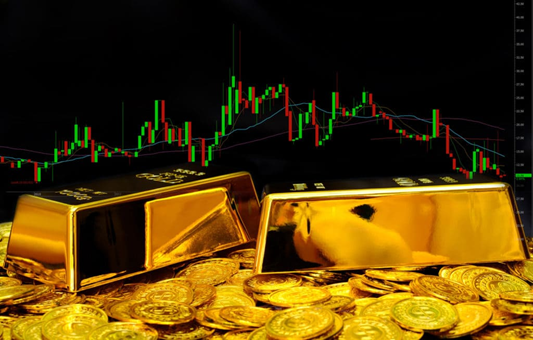
分析师普遍认为金价将上涨在年初,许多不同金融工具的预测都会发布。根据Goldsilver.com编制的预测,绝大多数黄金和白银预测都认为2023年将出现强劲上涨,其中盛宝银行预测今年金价可能上涨至3000美元(下图左侧第一行)。

Source: GoldSilver.com这样的预测应该持保留态度,因为我们在前几年看到过类似的预测最终没有实现。然而,今年许多因素表明,金属很可能突破1620-2070美元的盘整区间。在这种情况下,最值得关注的是美联储将在2月1日的会议上采取什么行动。声明的基调以及美联储主席杰罗姆·鲍威尔(Jerome Powell)随后召开的新闻发布会将是关键。最近几个月,我们看到了相对强硬的声明,因此基调的可能变化将成为买家的强大动力。 银在光伏中是不可替代的与黄金相比,银的工业用途要广泛得多。这种金属是最好的导体之一,在电子产品或光伏板等方面有着广泛的应用。随着世界向可再生能源过渡,对太阳能的需求将加速增长。这意味着对白银的需求也会增加。而且,有限的储量预计将在2050年耗尽,这将给价格带来上行压力。虽然人们已经开始尝试用铜元素取代银,并增加循环利用,但这项工作还处于非常早期的阶段。将这些解决方案付诸实践需要很多年甚至几十年的时间。除了工业用途,白银也是黄金的投资替代品,但规模较小。因此,推动黄金价格上涨的因素同样适用于白银。短期内,买家的第一个目标似乎是位于每盎司26美元价格区域的强劲需求区域(过去2年交易密集区)。这一突破将为银价触及每盎司30美元的心理阻力位开辟道路。
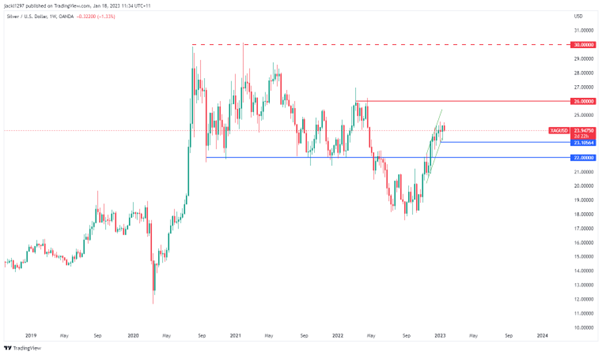
黄金价格突破1900美元自去年10月中旬以来,黄金一直处于动态上升趋势。金价目前已经突破每盎司1900美元的关键阻力位。如果金价短线回调站稳1900或1870美元将继续上涨(看起来很有可能),多头的下一个目标是每盎司2000美元的阻力位。在此之后,关键区域是历史高点2070美元。
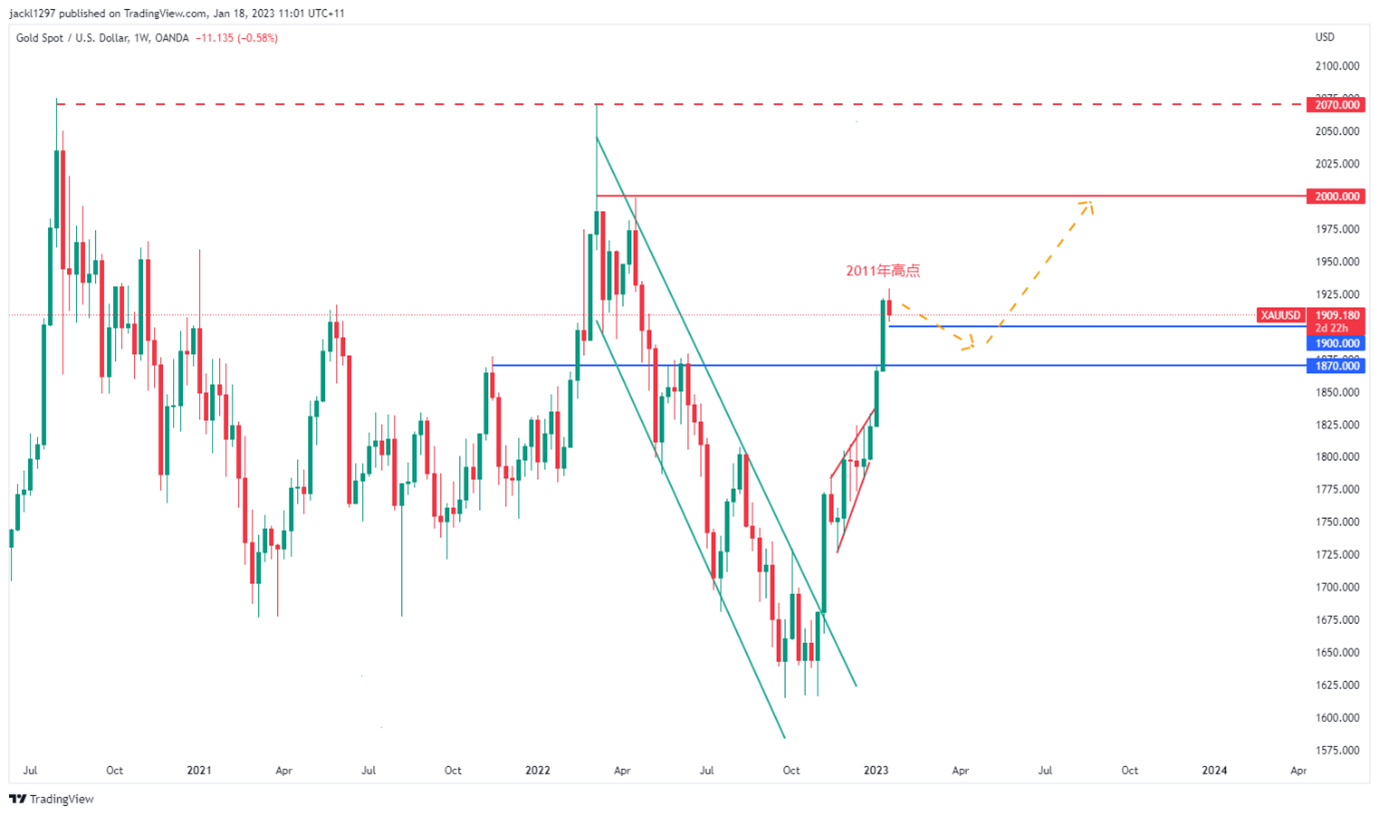
免责声明:GO Markets分析师或外部发言人提供的信息基于其独立分析或个人经验。所表达的观点或交易风格仅代表其个人;并不代表GO Markets的观点或立场。联系方式:墨尔本 03 8658 0603悉尼 02 9188 0418中国地区(中文) 400 120 8537中国地区(英文) +248 4 671 903作者:Jack Lin | GO Markets 新锐分析师
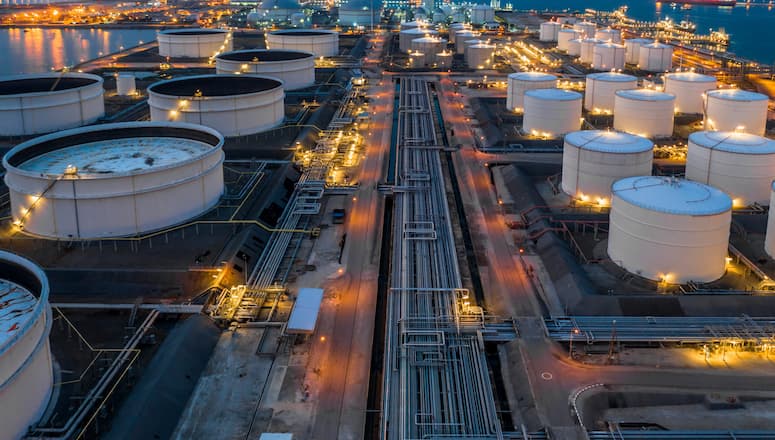

The price of Natural Gas has continued its drive back down after peaking in the middle of last year. The price has had an aggressive sell off after an equally aggressive run during the initial stages of the Russian and Ukraine conflict. This was due to Russian gas exports being banned and elevated inflation levels.
However, as the conflict has subsided the price of gas has returned to its seasonal trends. In addition, in recent weeks warmer weather has reduced the reliance on the energy source for much of Europe. The chart from a technical perspective is exceptionally bearish.
For the better part of a decade the price was ranging between 1.5 – 6.5. The aggressive move in 2022 as discussed was due to the beginning of the Russia and Ukraine crisis. The price since then looks to have made a head and shoulders pattern which is a bearish reversal pattern.
The neckline was at 5.5 and was broken through. The price has also broken down through the 200-day EMA on fairly aggressive volume. By zooming out, it can be seen that the recent sell off has been the price moving back into its long-term consistent range.
Therefore, the price should be nearing a bottom. As the price approaches 1.5/2 it may become a good opportunity for a long trade. An initial target at the top of the range of 6.6 could be a reasonable target for this medium-term swing trade.
The daily chart confirms this move and shows how the price has broken through the mid-level of support at 3.5. The daily chart also shows how the volume has been reducing significantly indicating some potential exhaustion in the short term and a spike in buying may be favorable for an upward thrust in price. Ultimately, the price of Gas could gain momentum if Europe’s winter brings about cooler weather or if China’s demand increases as it moves out of its Covid 19 restrictions increasing demand.
With volatility still high for the price of a natural gas caution should still be had when placing a trade.
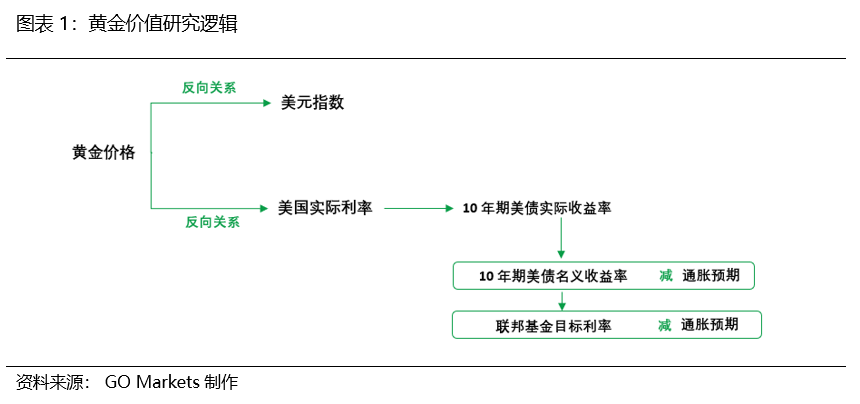

上次我们分析了美国此次公布的CPI数据以及对黄金走势做了预期。本期我们来谈谈,跟踪黄金价格,需要注意哪些指标以及回顾2018 年加息,周期是否会重现。

黄金价格与十年期美债实际收益率以及美元指数呈现反向关系。从图表2中我们可以看到从2003年至今,大多数情况下黄金价格走势都与美国十年期国债实际收益率呈现反向走势,可谓此消彼长。因此,预测十年期美债实际收益率也就可以进一步预测黄金走势。那如何预测十年期美债实际收益率呢?它等于十年期美债名义收益率减去通胀预期。而十年期美债名义收益率主要由美联储调节的联邦基金目标利率水平来决定。因此,我们需要跟踪观察的是美联储的利率政策和通胀预期,这也是为什么当前市场上对此两个指标的关注度非常高的原因。

另一方面,如图表3所示,美元指数也与黄金价格呈现反向关系。那美元指数如何来跟踪?归根结底还是与美联储利率政策有关,当美联储加息时,美元指数就会走强,而美联储暂缓加息甚至降息时,美元指数就会有下行趋势。而美联储的利率政策也与当前通胀水平存在一定联系。例如本次美国公布了最新的CPI也就是通胀数据,12月美国的通胀保持了下跌的趋势,那么整个市场也预期美联储是否会放缓加息甚至降息,一旦发生降息的话,可以预测到的就是美元指数可能会下行,随之而来的就是黄金会上涨,这也是为什么当前市场上有很大一部分预期黄金价格会上涨。所以整体来讲,投资者需要关注的还是美联储的利率政策与当前的通胀水平与通胀预期这些指标。
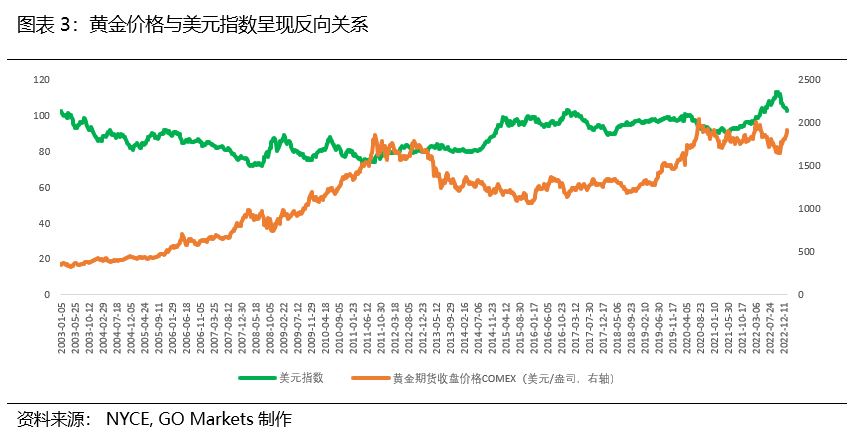
类比2018年,黄金价格走势是否还会重现规律?如图表4所示,上一次加息周期从2015 年 12 月开始,到2018 年 9 月结束,彼时共加息9次 共225bp。2018年12月上一轮最后一次加息25bp,此后黄金价格开始震荡上升,中途也经历一次大跌。2019年9月开始加息周期后的第一次降息25bp,此后黄金价格飙升。结合当前的形势判断,最后一次加息为黄金上涨起点,但并不稳定,第一次降息为真正飙升的起点。因此,参照上次加息周期的规律,我们仍然需要密且关注美联储本次的加息终点与首次降息的时刻。
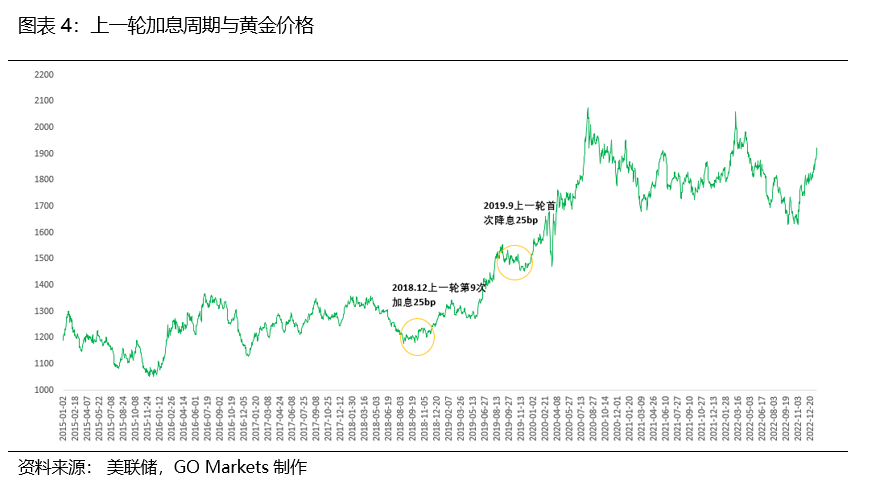
免责声明:GO Markets分析师或外部发言人提供的信息基于其独立分析或个人经验。所表达的观点或交易风格仅代表其个人;并不代表GO Markets的观点或立场。联系方式:墨尔本 03 8658 0603悉尼 02 9188 0418中国地区(中文) 400 120 8537中国地区(英文) +248 4 671 903作者:Yiduo Wang | GO Markets 助理分析师


The outlook for the Australian equities market is one of the best globally and is set up to cope with a potential recession. The Australian market showed itself to be robust in much of the volatility and downturn of last year being one of the more solid economies. This relative strength has carried so far into 2023 and has largely been due to the resource heavy nature of the ASX with most companies on the index being large resource and mining.
The XJO was also geographically protected from much of the geopolitical conflict in Europe that many European markets had to suffer through. The XJO is currently just 300 points off its all time high and with improving commodity prices it is well placed to weather a recessionary storm. A reopening of China may further support growth of the Australian market because growth in China may help various sectors such as travel, construction, manufacturing, and resources.
Lastly, as the Central banks across the world look at lowering interest rates it will only help growth economies such as Australia. Risk assets such as the Technology sector and growth economies should benefit as the cost of borrowing comes down. Although Banks will have to balance the need to lower rates with the need to tame inflation and the fight between which is a worse evil to fight will be much of the talking point of 2023.
Technical Analysis As stated above the XJO is currently just about 300 points below its all-time highs and is trending towards that target. Firstly, on the weekly chart the XJO has been able to maintain a tight range over the last 2 years. Once the dust had settled after the Covid 19 pandemic the price developed a range between 6412 and 7634.
The price also bounced of 6412 its long-term support twice in 2022 before pushing higher. Importantly, since October 2022, the XJO has been able to stay above the 50-week moving average as it has gained momentum. On the daily chart the price has broken to level not seen since April 2022.
Therefore, it is likely that the price may face some significant resistance as it approached 7600. Another positive sign is that the short term 50 day moving average has crossed back over the longer term 200 day moving average. This indicates that momentum is beginning to shift towards the bulls.
With more information still to come out, the Australian equities market is as well placed as any to deal with any potential macroeconomic factors that come its way.

